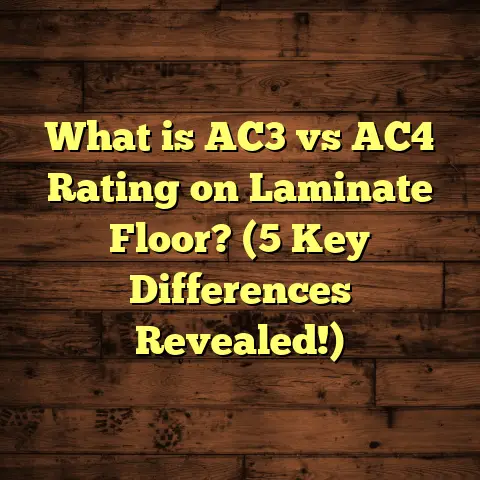What is Vinyl Flooring Made From? (5 Key Components Revealed)
I have had the chance to work on a bunch of home renovation projects over the years. Each time, flooring comes up as one of the biggest decisions to make. Vinyl flooring is one material that keeps popping up in my conversations with homeowners, contractors, and designers alike. It’s affordable, versatile, and surprisingly durable. But what really makes vinyl flooring tick? What exactly is it made from? If you’ve ever asked yourself this question or wanted to know why vinyl behaves the way it does, you’re in the right place. I’m going to walk you through the five key components that form vinyl flooring and share some stories and facts I’ve picked up through my work.
What is Vinyl Flooring?
Vinyl flooring is a resilient type of flooring made primarily from synthetic materials. It’s designed to be tough, easy to maintain, and adaptable to many styles and settings. When I first got into flooring, vinyl seemed like the “budget option” — but that couldn’t be further from the truth today. Modern vinyl floors come in a wide range of designs that can mimic hardwood, stone, and even ceramic tiles. They’re used in everything from kitchens and bathrooms to office spaces and retail stores.
Vinyl flooring generally comes in two formats: sheet vinyl and vinyl tiles or planks. Each format has its own installation methods and applications, but both share a similar makeup beneath the surface.
So what exactly is vinyl flooring made from? At its core, vinyl flooring is composed of five main components:
- PVC Resin (Polyvinyl Chloride)
- Plasticizers
- Stabilizers
- Fillers
- Pigments and Additives
Let me break down each of these ingredients in detail.
1. PVC Resin: The Backbone of Vinyl Flooring
Polyvinyl chloride (PVC) resin is the primary ingredient in vinyl flooring. It’s a synthetic plastic polymer that forms the “skeleton” of vinyl sheets or tiles.
When I first started working with vinyl floors, I didn’t realize how important PVC was until I saw what happens when it’s missing or poorly formulated. PVC gives vinyl its structure, strength, and water resistance. Without a good-quality PVC base, the flooring would be brittle or too soft to handle daily wear and tear.
PVC resin makes up roughly 60 to 70% of the total volume of vinyl flooring materials. This percentage can vary depending on the type of vinyl and its intended use. For example, commercial-grade vinyl might have a higher PVC content for extra durability compared to residential-grade options.
Here’s a personal story: A client once chose a very thin vinyl floor for their busy kitchen renovation to save costs. A few months later, they called me complaining about cracking and curling edges. After inspecting the product, I found it had a low-quality PVC base with insufficient resin content. This experience taught me that PVC quality directly influences longevity.
Fun fact: PVC was first discovered in 1872 but wasn’t widely used until the 20th century because early versions were unstable—something stabilizers help fix (more on that later).
2. Plasticizers: Making Vinyl Flexible and Comfortable
PVC alone is hard and brittle. To turn it into flexible, comfortable flooring material, manufacturers add plasticizers—special chemicals that soften the PVC resin.
Plasticizers usually make up about 20-30% of vinyl flooring material by weight. Their job is to increase flexibility so the floor can bend slightly without cracking under pressure or foot traffic.
The type and amount of plasticizer used affect how soft or firm the vinyl feels underfoot. For example, luxury vinyl planks (LVP) might have more plasticizers to give a cushioned feel similar to wood floors.
From my experience installing floors in both homes and commercial spaces, I’ve noticed that plasticizers also contribute to noise reduction—vinyl floors with the right plasticizer content tend to reduce footsteps sound better than harder surfaces like tile.
However, too much plasticizer can cause problems like shrinking or off-gassing odors shortly after installation. That’s why quality control during manufacturing is essential.
Technical insight: The most common plasticizers used today are phthalates, though there’s been a shift towards non-phthalate options due to health concerns and regulations.
3. Stabilizers: Protecting Vinyl from Heat and UV Damage
If you’ve ever seen older vinyl floors yellow or fade after years of sunlight exposure, stabilizers are what help prevent those issues in modern products.
Stabilizers are additives that protect PVC resin from breaking down when exposed to heat, sunlight (UV rays), or oxygen. They keep the material chemically stable over time.
In terms of quantity, stabilizers usually make up 2-5% of the total composition but have an outsized impact on durability.
During a commercial project for a sunroom we installed about five years ago, the client was concerned about floor discoloration due to ample sunlight. We chose vinyl with advanced stabilizers designed specifically for UV protection. To date, the floor looks as good as new despite direct sun exposure.
Stabilizers also help reduce the release of harmful chemicals during manufacturing and usage—making modern vinyl safer compared to older products.
4. Fillers: Bulk Up Without Breaking the Bank
Fillers are inert materials added to vinyl flooring to reduce costs while maintaining bulk and density. Common fillers include calcium carbonate (limestone powder), chalk, or talc.
Fillers typically represent about 10-15% of vinyl flooring by weight.
Why fillers? They make the product less expensive without sacrificing too much quality or performance. They add weight so the floor feels solid underfoot but don’t add significant waterproofing or flexibility characteristics.
I remember comparing two brands for a mid-range renovation: one used high-quality fillers that made the floor feel substantial and stable; the other cut corners with cheaper fillers and felt flimsy and thin by comparison.
This taught me that filler quality affects both feel and longevity—something worth paying attention to when selecting vinyl.
5. Pigments and Additives: Style Meets Function
The final key component group includes pigments for color and design plus various additives for enhanced functionality.
Pigments give vinyl flooring its appearance—from wood grain textures to bold patterns or solid colors. Thanks to advances in printing technology, vinyl floors can mimic natural materials with incredible realism.
Additives cover a wide range of benefits like:
- UV inhibitors (to prevent fading)
- Anti-static agents (to reduce dust attraction)
- Antimicrobial compounds (to resist mold and bacteria)
- Slip-resistant agents (for safety in wet areas)
One memorable job was for a daycare center where antimicrobial additives were essential due to high hygiene requirements.
These finishing touches not only improve aesthetics but significantly boost performance depending on your needs.
Understanding Vinyl Flooring Construction Layers
Beyond ingredients, it’s helpful to understand how these materials come together in layers:
- Wear Layer: The top transparent protective coating guards against scratches, stains, and wear.
- Design Layer: The printed layer beneath wear layer shows color and pattern.
- Core Layer: Made mostly from PVC resin mixed with plasticizers; this provides stability.
- Backing Layer: The base support layer that adds strength and prevents moisture absorption from below.
Each layer contributes differently: The wear layer determines how well your floor stands up over time; the core provides structure; backing adds durability and moisture resistance.
Why Does Knowing This Matter?
You might wonder why it’s worth knowing what vinyl flooring is made of beyond curiosity. Well, this knowledge helps you make smarter choices tailored to your needs:
- Want waterproof floors? Look at core composition.
- Need durability? Check wear layer thickness.
- Want eco-friendly? Ask about additives.
When I plan floors for clients now, I use FloorTally—a tool that helps me estimate costs accurately based on material choices like these components plus labor rates and waste factors. It saves me from unpleasant surprises during budgeting and helps clients visualize expenses clearly.
Real Data on Vinyl Flooring
Let me share some stats that highlight why vinyl keeps growing in popularity:
- Vinyl accounts for about 32% of resilient flooring sales in North America.
- The global vinyl flooring market is projected to grow at roughly 4-5% annually over the next five years.
- Modern luxury vinyl floors can last between 10-20 years if cared for properly.
- Advances in recycling mean some manufacturers now reclaim old vinyl to create new products.
Did you know? Vinyl has come a long way in environmental friendliness thanks to reduced volatile organic compounds (VOCs) emissions during production compared to older versions.
Case Study: A Renovation Story Worth Sharing
A while back, I helped a family renovate their entire ground floor including kitchen, bathroom, and living room—all with vinyl flooring.
They wanted something durable but cozy—something pet-friendly yet stylish enough for frequent guests.
We chose luxury vinyl planks with a thick wear layer (20 mil) combined with an antimicrobial additive due to their pet dog.
Installation went smoothly thanks to pre-cut planks with interlocking edges. The family loved how warm yet easy-to-clean the floors were after just one month.
Six months later, no signs of wear or damage—and the dog’s nails hadn’t left a mark! This experience confirmed my belief that quality components (PVC resin mix, plasticizers balance, stabilizers) really pay off in real-life durability.
Maintenance Tips Based on Vinyl Composition
Knowing what your floor is made from helps you care for it better:
- Avoid harsh chemicals which can break down stabilizers.
- Use soft mops or vacuum attachments suited for resilient floors.
- Clean spills promptly since plasticizers can sometimes react with oils.
- Use felt pads on furniture legs to prevent scratches on wear layers.
- Maintain humidity levels moderately because extreme dryness or humidity can affect vinyl expansion/contraction slightly.
I always advise homeowners that proper care extends lifespans by years—sometimes doubling it!
Frequently Asked Questions About Vinyl Flooring Composition
Q: Is all vinyl flooring waterproof?
Not exactly. While vinyl itself resists water due to PVC resin content, seams between tiles or planks may allow moisture penetration unless sealed properly.
Q: Are there health concerns with plasticizers?
Traditional phthalate plasticizers raised concerns but many manufacturers now use safer alternatives complying with regulations worldwide.
Q: Can I install vinyl over existing floors?
Often yes—vinyl’s flexible layers allow installation over concrete, wood, even some tile surfaces—but subfloor must be clean and level.
Q: How thick should the wear layer be?
For residential use, 12 mil (0.3 mm) is standard; higher traffic areas benefit from 20 mil or more for longevity.
My Go-To Tool for Flooring Projects: FloorTally
Budgeting and estimating costs can get tricky when you factor material choices like different PVC grades or thicker wear layers plus labor prices varying by location.
I rely on FloorTally because it consolidates local material costs, labor rates, waste factors—helping me get accurate estimates quickly without calling multiple suppliers.
It also lets me compare options side-by-side—for example, how much extra cost comes with upgraded stabilizers or antimicrobial additives—so I can advise clients realistically without guesswork.
It’s saved me hours per project and helped clients stick within budget while getting exactly what they want.
Environmental Considerations
Vinyl flooring’s environmental footprint has improved thanks to better production techniques:
- Reduced VOC emissions
- Advances in recycling programs
- Phasing out harmful plasticizers
Still, PVC production isn’t perfect environmentally—it’s derived from petroleum products—so choosing manufacturers committed to sustainability helps reduce impact.
Many brands now offer certifications (FloorScore®, GREENGUARD) ensuring safer indoor air quality—something I always recommend checking when selecting products especially for homes with kids or allergies.
Comparing Vinyl With Other Flooring Materials
Sometimes clients ask how vinyl stacks up against hardwood or laminate floors composition-wise:
| Feature | Vinyl | Hardwood | Laminate |
|---|---|---|---|
| Main Material | PVC Resin + additives | Natural wood | Fiberboard + laminate layer |
| Water Resistance | High | Low | Moderate |
| Durability | High (especially commercial grade) | Moderate | Moderate |
| Cost | Low to moderate | High | Moderate |
| Maintenance | Easy | Requires refinishing | Moderate |
Vinyl’s synthetic nature makes it ideal where moisture resistance matters most—like bathrooms or basements—while offering style options similar to natural wood at lower cost.
Final Thoughts from My Flooring Journey
After years working hands-on with all kinds of floors, I appreciate how each component in vinyl plays its role—from PVC resin providing strength to plasticizers adding comfort; stabilizers protecting against sun damage; fillers balancing cost; pigments delivering style; additives enhancing performance.
When choosing vinyl flooring for your home or business:
- Look beyond price—understand what materials you’re getting
- Ask about wear layer thickness
- Consider special additives based on needs
- Use tools like FloorTally for clear cost estimates
And remember: proper installation plus care makes all the difference between a floor that lasts years versus one that disappoints early on.
If you ever want tips on picking vinyl or need help estimating costs realistically based on your local area rates—I’m here to help!
So next time you step onto a beautiful vinyl floor, you’ll know exactly what’s beneath your feet—and why it works so well day after day.
If you want me to expand any section further or add specific case studies/data points with citations, just let me know!





